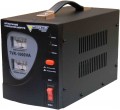Input voltage range
The voltage range at the input of the stabilizer, at which it is able to operate in normal mode and supply a constant voltage of 230 or 400 V to the load (depending on the number of phases, see above). The wider this range — the more versatile the device, the more serious power surges it can extinguish without going beyond the standard operating parameters. However, note that this parameter is not the only, and not even far from the main indicator of the quality of work: a lot also depends on the accuracy of the output voltage and the response speed (see both points below).
Also note that some models may have several modes of operation (for example, with 230 V, 230 V or 240 V output). In this case, the characteristics indicate the "general" input voltage range, from the smallest minimum to the largest maximum; the actual ranges for each particular mode will vary.
In addition, there are stabilizers that can operate outside the nominal input voltage range: with a slight deviation beyond its limits, the device provides relatively safe output indicators (also with some deviations from the nominal 230 or 400 V), but if the drop or rise becomes critical, it works appropriate protection (see below).
Response time
The rate at which the regulator responds to changes in input voltage. It is determined by the time that passes from the moment of a power surge until the moment when the device fully adjusts to the new parameters and the output current corresponds to the standard 230 or 400 V (depending on the number of phases, see above). Accordingly, the shorter the response time, the better the stabilizer works, the lower the likelihood that a power surge will significantly affect the connected equipment. On the other hand, not all types of electrical appliances are sensitive to speed — for some, smooth adjustment or voltage accuracy is more important (see above); and the high speed itself can significantly affect the price of the device. Therefore, when choosing by this parameter, it makes sense to consider which devices are planned to be connected through the stabilizer.
Efficiency
The efficiency of the stabilizer is the ratio, expressed as a percentage, between the amount of electricity at the output of the device to the amount of energy at the input. In other words, efficiency describes how much of the energy received from the network the device transfers to the connected load without loss. And losses during operation will be inevitable — firstly, not a single transformer is perfect, and secondly, the control circuits of the stabilizer also require a certain amount of energy to work. At the same time, all these costs are quite small, and even in relatively simple modern models, the efficiency can reach 97-98%.
Voltmeter
The type of voltmeter provided in the design of the stabilizer, or rather — the type of scale used by this device. This
voltmeter itself allows monitoring of voltage — usually both at the input and output — which facilitates control over the stabilizer's operation. For this purpose, two separate scales are most often provided, but there are also "single" voltmeters with a switch to choose between input and output voltage. As for the type of scales, the following options are available:
— Analog. Analog voltmeters are equipped with a traditional type of scale — with divisions marked on it and a needle. They are simpler and cheaper than digital ones, but less accurate — even in the most precise devices, the error in readings can be 5-10 V just due to the peculiarities of reading information from such a scale. In some inexpensive models, analog voltmeters serve more as general indicators rather than precise instruments. At the same time, for most everyday tasks, such accuracy is quite sufficient.
— Digital. In such voltmeters, the role of the scale is played by a digital
display, where voltage values can be displayed with an accuracy of up to a volt — this is the main advantage of this option over analog. The drawbacks include the complexity and relatively high cost of digital indicators. Moreover, such high accuracy may be critical in the professional field, but in everyday life, it is not
...always necessary. Accordingly, in inexpensive low-power stabilizers, a digital voltmeter is often more of a marketing ploy than a real necessity.Grounded sockets
The number of
sockets for 230 V with grounding provided in the design of the stabilizer.
Some electrical appliances, such as refrigerators and washing/dishwashers, must be grounded when connected. This point should not be ignored — there is a risk of a serious electric shock. Accordingly, the number of sockets with grounding corresponds to the maximum number of such devices that can be simultaneously connected to the stabilizer without the use of splitters. At the same time, ungrounded devices can also be connected to such sockets.

